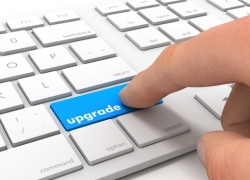Future proofing the data center with upgradeable hardware
Future proofing the data center with upgradeable hardware

In 2013, there were approximately 4.4 zettabytes of data in existence throughout the world. By 2020, that amount is expected to increase to a staggering 44 zettabytes. For context, researchers estimate that 42 zettabytes could contain every word ever spoken by humanity since the beginning of time, according to TechCrunch. Is it possible that this is what Douglas Adams had in mind when he wrote that "42" was the answer to life, the universe and everything? That, we may never know.
However, we can be certain that these exponential increases in existing data are heavily impacting the facilities responsible for housing, processing and transmitting it. Data center rack kW is rising. Meanwhile, scalability and flexibility are now central to streamlined, resilient business operations. To top it off, efficiency has been dragged back into the fray, partly because of the need to cut back operational spend, and partly as a result of the data center optimization initiative (DCOI) for federal agencies, which has brought the green data center discussion back to the fore.
That's the situation the modern data center has been plunged into. Data center infrastructure needs to be future-proofed, and sooner rather than later.
Challenges of change management
Facility and IT teams continue to hit road bumps as they attempt to refine the science behind impeccable data center management. Part of the problem is the sheer number of variables that need to be considered to analyze the health of a facility, and the granular level at which it must be understood. Data center management is a never-ending balancing act, or as TechRepublic contributor Scott Matteson put it, "preserving order in a chaotic world."
When change management is thrown into the mix, preserving that order becomes even more complicated. Simply swapping out one set of rack servers for another or transitioning to the use of ToR network switches can have an adverse impact on temperature, airflow or power distribution. It's sort of like juggling on a tightrope while trying to maintain balance and not drop anything as various items of differing weight are thrown at you.
To a significant extent, data center infrastructure management (DCIM) helps with this endeavor by analyzing metrics, making sense of them and visualizing how they relate to one another. Capacity planning and predictive modeling can even map out requirements based on future loads. However, DCIM doesn't change the fact that critical infrastructure equipment may not be able to support future needs, regardless of whether or not you're aware of those needs.
Long story short, future-proofing is easier said than done.

Why starting with PDUs is the smartest move
"Invest in upgradeable hardware wherever that opportunity exists."
Obviously, nothing can change in the data center without gauging the impact on electricity. Power distribution must be considered, both facility-wide and at the rack level, to prevent shorts. Therefore, as IT or power load changes, there's a strong chance that PDUs will be the first pieces of equipment that need to be replaced. Basic PDUs may be reliable, but if they lack customizable sensor ports, they risk becoming obsolete as the needs of the facility shift.
For instance, while a status-quo low-density setup may not warrant remote power monitoring or advanced daisy chaining capabilities, there's always the chance that you'll need to heavily reinvest in your power infrastructure later on should IT load shift. Likewise, if a need develops for greater IT flexibility, granular environmental monitoring may become a necessity to ensure that sudden load changes won't degrade rack performance.
At the same time, it's imprudent to invest in something just because you might need it someday. Future-proofing isn't about buying equipment you may need later; it's about strategically investing in technology that can accommodate foreseeable infrastructure requirements. And to that end, upgradeable PDUs with modular intelligence (ports for local or remote power monitoring, environmental sensors) is probably the easiest place to start.
In the coming years, CRACs may become more energy-efficient and server processing power will almost undoubtedly increase to accommodate the many new zettabytes being brought into the world every year. Equipment changes are inevitable – but that doesn't mean you can't minimize the amount of money you spend adjusting to them.
The moral of the story? Invest in upgradeable hardware wherever that opportunity exists.



